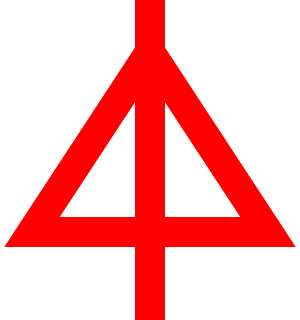
The 16th Infantry Division of the German Army was formed in 1934. On 26 August 1939 the division was mobilized for the invasion of Poland (1939). It participated in the Battle of France in August 1940. The division was then split, resulting in two independent units: The 16th Panzer Division and the 16th Motorized Infantry Division. The latter, from 1944 onward, combined with other non 16th elements, was known as the 116th Panzer Division.
The 164th Infantry Division was an infantry division of the German Army during World War II. Formed in November 1939, the division took part in the invasion of Greece in April 1941. In January 1942, consolidating the Axis seizure of the island during the Battle of Crete, the 164th was reorganized as Fortress Division Kreta (FDK). In mid-1942 the division was transferred to North Africa and re-designated as 164th Light Afrika Division. It surrendered in May 1943 in Tunisia at the end of the North African Campaign.
The 9th Luftwaffe Field Division was an infantry division of the Luftwaffe branch of the Wehrmacht that fought in World War II. It was formed using surplus ground crew of the Luftwaffe and served on the Eastern Front from late 1942 to June 1944. It was badly mauled during the Soviet offensive of January 1944 near Leningrad. It was later merged with the 225th Infantry Division.
The 19th Panzer Division was an armoured division in the German Army, the Wehrmacht, during World War II. It was created from the 19th Infantry Division.
The 4th Luftwaffe Field Division was an infantry division of the Luftwaffe branch of the Wehrmacht that fought in World War II. It was formed using surplus ground crew of the Luftwaffe and served on the Eastern Front from late 1942 to June 1944 when it was destroyed during Operation Bagration.
The 6th Luftwaffe Field Division was an infantry division of the Luftwaffe branch of the Wehrmacht that fought in World War II. It was formed using surplus ground crew of the Luftwaffe and served on the Eastern Front from late 1942 to June 1944 when it was destroyed during Operation Bagration.

The 87th Infantry Division was an infantry division of the German Army during the Second World War, active from 1939 to 1945.

The 14th Panzer Division was an armoured division in the German Army during World War II. It was created in 1940 by the conversion of the 4th Infantry Division.
Vollrath Lübbe was a German general in the Wehrmacht. A veteran of World War I, he rose to command several divisions during World War II. He was a recipient of the Knight's Cross of the Iron Cross, awarded by Nazi Germany to recognise successful military leadership.

The 31st Infantry Division was a German infantry division of the Army during World War II. It participated in the invasion of Poland in 1939 then the invasion of France and the Low Countries in 1940. As part of Panzergruppe 2. of Army Group Centre, it was involved in the invasion of the Soviet Union in June 1941. After hard fighting throughout 1941 and 1942 it joined the 9th Army and fought in the Battle of Kursk in July and August 1943. Along with the rest of the 9th Army, the division conducted a fighting withdrawal for the remainder of 1943, during which it sustained heavy casualties. In the early stages of the Soviet Operation Bagration of June to August 1944, the 31st Infantry Division was destroyed, a fate which subsequently befell most of Army Group Centre. The division was officially disbanded on 18 July 1944.

The 38th Infantry Division was a German Army infantry division in World War II. Formed in July 1942, it existed for a little over 15 months before being effectively destroyed in fighting on the Eastern Front in November 1943.

The 15th Panzer Division was an armoured division in the German Army, the Wehrmacht, during World War II, established in 1940.
The 174th Reserve Division was a formation of the German Wehrmacht during World War II. Formed as the 174th Replacement Division on 10 June 1940, it commanded replacement training units in Saxony and the Sudetenland, based in Chemnitz. It was re-organised as the 174th Reserve Division on 15 September 1942 in the Protectorate of Bohemia and Moravia. The division continued to control training units until 1943 when those elements of the division were sent to northern Poland. On 31 July 1944 the division was absorbed by the 26th Infantry Division which had suffered heavy losses in the Battle of Kursk. The 26th Infantry Division was badly mauled at Kovel on the Eastern Front, and on 10 September 1944 was itself disbanded at Radom in central Poland and was absorbed into the 253rd Infantry Division.
The 462nd Volksgrenadier Division was a Volksgrenadier division of the German Army during the Second World War, active from 1942 to 1944.
The 361st Infantry Division was an infantry division of the German Army during the Second World War, active from 1943 to 1945. It was redesignated as a Volksgrenadier division in 1944. It saw active service on the Eastern Front when the Soviets launched Operation Bagration, during which it suffered significant losses. It later fought in France before being absorbed by the 559th Volksgrenadier Division on 10 March 1945.
The 362nd Infantry Division was an infantry division of the German Army during the Second World War, active from 1943 to 1945. Formed in Italy, it participated in the Italian Campaign for the entire duration of its war service. It was implicated in the massacre of 97 civilians in what is known as the Benedicta massacre, which occurred at Piedmont in April 1944.
The 335th Infantry Division was an infantry division of the German Army during the Second World War, active from 1940 to 1944. It saw active service in France and on the Eastern Front and was destroyed in fighting in Romania in August 1944.
The 336th Infantry Division was an infantry division of the German Army during the Second World War, active from 1940 to 1944. It saw active service in France and on the Eastern Front. Largely destroyed during the Crimean Offensive, it surrendered to the Soviets at Sevastopol in May 1944.

The 387th Infantry Division was an infantry division of the German Army during the Second World War, active from 1942 to 1944. It saw active service on the Eastern Front and was destroyed in fighting in Romania in August 1944.

The 376th Infantry Division was an infantry division of the German Army during World War II, active from 1942 to 1944 in two separate instances.







